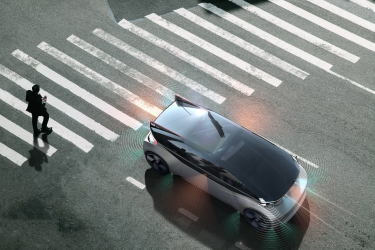Latest News From Bumper to Bumper Radio

GOTHENBURG, Sweden, Dec. 22, 2020 - Volvo Cars has established itself as one of the leaders in autonomous drive development, following its announcement earlier this year that its next generation of cars will be available as hardware ready for the technology from production start.
At the same time, the company is also looking further into the future, considering how autonomous cars will communicate with other road users in a driverless world. This research looks beyond current Highway Pilot plans, which aims to have cars drive safely on their own on chosen areas of highway that Volvo has verified as safe. To design this future, however, Volvo's experts are seeking inspiration from the past.
"We make no secret about the fact that we see autonomous drive as the real long-term solution to avoid car accidents and to achieve traffic safety," says Mats Moberg, Senior Vice President of R&D at Volvo Cars. However, as is always the case at Volvo Cars, safety is the first concern.
The Volvo 360c autonomous concept car, unveiled in 2018, provides one possible avenue of future development. It explores the type of safety-focused communication Volvo Cars believes will be essential to cars of the future when it comes to sharing the road with other road users, including other vehicles, cyclists and pedestrians. The design for the 360c explores a combination of external sounds, lights, and even subtle movements to communicate the vehicle's intentions to other road users.

Three-quarters of Americans are expected to stay home; AAA advises caution for those who decide to travel
ORLANDO, Fla. (December 15, 2020) – AAA Travel expects the vast majority of Americans to stay home this holiday season. Public health concerns and travel guidance are influencing their decisions not to travel over the year-end holidays, a period that typically sees high demand for vacations. While AAA expects at least 34 million fewer travelers compared to last year’s holiday season, as many as 84.5 million Americans may still travel from Dec. 23 through Jan. 3, a decline in travel of at least 29%.
“While Thanksgiving is traditionally spent gathering with friends and family, the year-end holidays are when Americans often venture out for longer, more elaborate vacations. That will not be the case this year,” said Paula Twidale, senior vice president, AAA Travel. “Public health concerns, official guidance not to travel, and an overall decline in consumer sentiment have encouraged the vast majority of Americans to stay home for the holidays.”
The CDC urges Americans not to travel for the holidays this year, warning that travel increases your chance of getting and spreading COVID-19.
For those who make the personal decision to travel, it is important to understand the risks involved and take steps to keep yourself and others safe. Seek the advice of a trusted travel advisor and refer to AAA’s COVID-19 Travel Restrictions Map and TripTik.AAA.com for the latest state and local travel restrictions, and to help determine which rest stops, gas stations, restaurants and hotels are open along your route.
What to Know Before You Go
Plan Ahead. Check with state and local officials along your route and at your destination to learn about local guidance and any restrictions that may be in place. This includes what is expected of you when you return home. Many localities are requiring COVID-19 testing prior to and after travel.
Follow Public Health Guidance.

As cars keep getting smarter, automation is taking many tricky tasks -- from parallel parking to backing up -- out of drivers' hands.
Now, a University of Toronto Engineering study is underscoring the importance of drivers keeping their eyes on the road -- even when they are in an automated vehicle (AV).
Using an AV driving simulator and eye-tracking equipment, Professor Birsen Donmez and her team studied two types of in-vehicle displays and their effects on the driving behaviours of 48 participants.
The findings, published recently in the journal Accident Analysis & Prevention, revealed that drivers can become over-reliant on AV technology. This was especially true with a type of in-vehicle display the team coined as takeover request and automation capability (TORAC).
A "takeover request" asks the driver to take vehicle control when automation is not able to handle a situation; "automation capability" indicates how close to that limit the automation is.
"Drivers find themselves in situations where, although they are not actively driving, they are still part of the driving task -- they must be monitoring the vehicle and step in if the vehicle fails," says Donmez.

AAA urges motorists to keep their cool as research shows differences between men and women regarding aggressive driving behavior
WASHINGTON, D.C. (December 3, 2020) Data gathered by the AAA Foundation for Traffic Safety confirms the perception that men tend to speed, tailgate, merge dangerously, and make rude gestures or honk at other drivers more than women. The survey finds that women also admit to some dangerous driving habits, such as running red lights. Overall, younger male and female drivers tend to be more aggressive than older drivers. With everyday stress already compounded by the pandemic and now the holiday season, which can elevate tensions on the road, AAA urges motorists to keep their cool and avoid dangerous driving habits.
Regardless of gender, nearly 8 in 10 (79%) American drivers demonstrate aggressive behaviors when behind the wheel. Speeding tops the list, with men being the biggest culprit, though women are not far behind. Contrary to common perception, speeding does not save time on the road. The average amount saved on a 5-mile trip, driving 65 mph on a 45 mph posted road, is only 1.9 minutes.
“Speeding, red-light running, and cutting other drivers off can kill you, your passengers, and others sharing the road,” said Jake Nelson, AAA’s director of traffic safety advocacy. “Driving aggressively isn’t worth the risk. When you get behind the wheel, be patient, be kind, and obey traffic laws so everyone gets home safely.”

A vacation, let alone a road trip, might sound very daunting or impossible during a pandemic. However, there are ways to keep safe if you do have to travel. Not only do YOU need to keep healthy and safe during a road trip, but your vehicle needs to be kept “healthy” and safe too!
Packing everything you need is key because you may be in a remote area with no internet access, or ability to buy groceries and drinking water. Keep reading to learn some tips on keeping safe while road tripping!
Is Road Tripping Safe During Covid-19?
Stepping out of isolation can put anybody at risk for Covid-19 during these times. However, taking a road trip is safer than being exposed to public transport and flights. Depending on where you are located, there may or may not be restrictions on domestic travel. The CDC has warned that car travel can present some risk because it’s usually necessary to make stops along the way for gas, food, or restroom breaks. And, it’s a possibility to come in contact with other people and surfaces. There are some things you can do, however, to mitigate your risk.






















